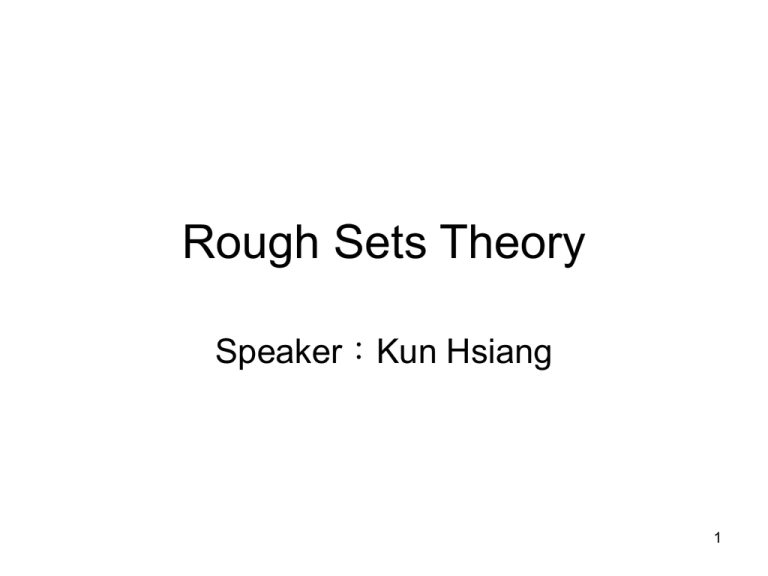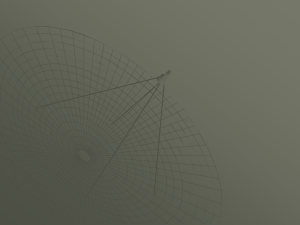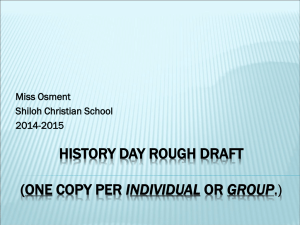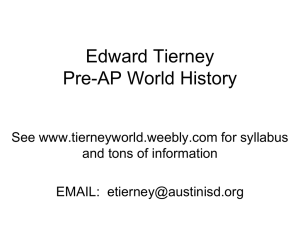RoughSetsTheoryIntro_KunHsiang
advertisement

Rough Sets Theory
Speaker:Kun Hsiang
1
Outline
•
•
•
•
•
Introduction
Basic concepts of the rough sets theory
Decision table
Main steps of decision table analysis
An illustrative example of application of the
rough set approach
• Discussion
2
Introduction
• Often, information on the surrounding
world is
– Imprecise
– Incomplete
– uncertain.
• We should be able to process uncertain
and/or incomplete information.
3
Introduction
• When dealing with inexact, uncertain, or
vague knowledge, are the fuzzy set and
the rough set theories.
4
Introduction
• Fuzzy set theory
– Introduced by Zadeh in 1965 [1]
– Has demonstrated its usefulness in chemistry
and in other disciplines [2-9]
• Rough set theory
– Introduced by Pawlak in 1985 [10,11]
– Popular in many other disciplines [12]
5
Introduction
• Fuzzy Sets
6
Introduction
• Rough Sets
– In the rough set theory, membership is not
the primary concept.
– Rough sets represent a different mathematical
approach to vagueness and uncertainty.
7
Introduction
• Rough Sets
– The rough set methodology is based on the premise
that lowering the degree of precision in the data
makes the data pattern more visible.
– Consider a simple example. Two acids with pKs of
respectively pK 4.12 and 4.53 will, in many contexts,
be perceived as so equally weak, that they are
indiscernible with respect to this attribute.
– They are part of a rough set ‘weak acids’ as
compared to ‘strong’ or ‘medium’ or whatever other
category, relevant to the context of this classification.
8
Basic concepts of the rough sets
theory
• Information system
– IS=(U,A)
– U is the universe ( a finite set of objects,
U={x1,x2,….., xm}
– A is the set of attributes (features, variables)
– Va is the set of values a, called the domain of
attribute a.
9
Basic concepts of the rough sets theory
Consider a data set containing the results of three
measurements performed for 10 objects. The results
can be organized in a matrix10x3.
Measurements
Objects
10
Basic concepts of the rough sets theory
•
•
•
•
IS=(U,A)
U={x1,x2,x3,x4,x5,x6….., x10}
A={a1,a2,a3}
The domains of attributes are:
V1={1,2,3}
V2={1,2}
V3={1,2,3,4}
11
Basic concepts of the rough sets theory
12
Basic concepts of the rough sets theory
13
Basic concepts of the rough sets theory
14
Basic concepts of the rough sets theory
15
Basic concepts of the rough sets theory
16
Basic concepts of the rough sets theory
17
Basic concepts of the rough sets theory
18
Basic concepts of the rough sets theory
19
Basic concepts of the rough sets theory
20
Basic concepts of the rough sets theory
21
Basic concepts of the rough sets theory
If B ( X ) 1, X is crisp with respect to B.
If B ( X ) 1, X is rough with respect to B.
22
Basic concepts of the rough sets theory
23
Basic concepts of the rough sets theory
• If the set of attributes is dependent, one can be
interested in finding all possible minimal subsets
of attributes.
• The concepts of core and reduct are two
fundamental concepts of the rough sets theory.
– Keep only those attributes that preserve the
indiscernibility relation and, consequently, set
approximation.
– There are usually several such subsets of attributes
and those which are minimal are called reducts.
24
Basic concepts of the rough sets theory
• To compute reducts and core, the
discernibility matrix is used.
• The discernibility matrix has the dimension
nxn.
• where n denotes the number of
elementary sets and its elements are
defined as the set of all attributes which
discern elementary sets [x]i and [x]j .
25
Basic concepts of the rough sets theory
26
Basic concepts of the rough sets theory
27
Basic concepts of the rough sets theory
Discerns set 1 from both set 2 and set 3
Discerns set 1 from sets 2,3,4 and set 5
28
Basic concepts of the rough sets theory
The discernibility function has the following form:
29
Basic concepts of the rough sets theory
30
Basic concepts of the rough sets theory
31
Basic concepts of the rough sets theory
32
Basic concepts of the rough sets theory
33
Basic concepts of the rough sets theory
34
Basic concepts of the rough sets theory
35
Basic concepts of the rough sets theory
Classification:
36
Basic concepts of the rough sets theory
37
Basic concepts of the rough sets theory
38
Basic concepts of the rough sets theory
39
Basic concepts of the rough sets theory
40
Basic concepts of the rough sets theory
Decision Table:
41
Basic concepts of the rough sets theory
42
Basic concepts of the rough sets theory
43
Basic concepts of the rough sets theory
44
Basic concepts of the rough sets theory
45
Basic concepts of the rough sets theory
46
Basic concepts of the rough sets theory
47
Basic concepts of the rough sets theory
48
Basic concepts of the rough sets theory
49
Basic concepts of the rough sets theory
50
An illustrative example of application of the
rough set approach
51
An illustrative example of application of the
rough set approach
52
An illustrative example of application of the
rough set approach
53
An illustrative example of application of the
rough set approach
54
An illustrative example of application of the
rough set approach
55
An illustrative example of application of the
rough set approach
56
Discussion
57








